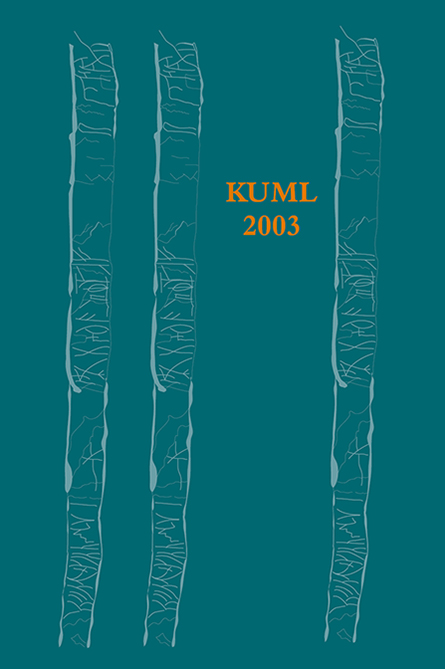Ravning-broens alder – En af Danmarks sikreste dendrokronologiske dateringer?
DOI:
https://doi.org/10.7146/kuml.v52i52.102644Nøgleord:
Ravning-broen, alder, dendrokronologiske dateringResumé
The age of Ravning Bridge.One of Denmark’s most reliable dendrochronological datings?
The excavation of the large Viking Age bridge across the Vejle river valley began at the same time that the dendrochronological dating method came into use in Denmark. In 1977, Thorkild Ramskou, who excavated the bridge, announced that the tree ring dating of the timber showed that the bridge “was built in 979 or at least very close to that year”. In 1998, Mogens Schou Jørgensen, who continued the archaeological excavations of the bridge structure after Ramskou’s death, stated, “The dating of Ravning Bridge is one of the most reliable from the Danish Viking Age. Almost 100 dendrochronological datings of timber exist, and they point at 979 or 980 as the felling year of the oak trees”. In 2000 Steen Hvass gave an even more precise dating for the bridge: “The bridge across Ravning Enge was constructed between October 979 and April 980.”
However, the dating is not nearly as scientifically based and precise as these quotations indicate. Around 100 samples from the bridge were taken for dating, but so far tree ring measurements have only been made on 25 of them, and of these only 18 could be dated (table1). Out of these 18, only four samples contained sapwood, and none definitely included the bark ring – i.e. the last tree ring just under the bark. In spite of the quoted statements, not a single investigated sample from the bridge gives a precise year for when the trees were felled and the bridge was built.
The measuring of the tree rings and the dating of the samples was mostly carried out at the dendrochronological laboratory in Hamburg, and the results are completely reliable. The investigation showed that the latest preserved tree ring on the dated samples, which was found on post no. 26, was formed in the year 979, and that the bridge could therefore not have been built until the autumn of that year, or later (fig. 1). However, as no bark was preserved on this post, one or more missing tree rings cannot be excluded, and the tree may well have been felled later.
As for the samples with preserved sapwood, the probable felling year of the trees may be determined (although with some uncertainty), since the number of tree rings in the sapwood varies only within a rather limited range. When calculating the year of felling, the Hamburg laboratory assumed that the trees had originally had 20 +/- 5 tree rings in the sapwood, as this was considered normal for 1-200 year-old oak trees. The report of the dating which the laboratory gave in 1975 specifies the felling time of the four trees with preserved sapwood as 979-988. This result accords well with Thorkild Ramskou’s first announcement about the dating, but it does not provide a basis for claiming that the timber for the bridge was definitely felled in 979 or 980.
Later, a reconsideration of the dated samples has shown that the trees used for building the bridge were older than first assumed (fig. 2). The average age of the trees from which the dated samples stem is almost 300 years, and more trees were close to 500 years old at the time of felling. Consequently, the trees are likely to have had more tree rings in the sapwood than first thought and so they must have been felled later than has hitherto been assumed (as the felling year is found by adding the assumed number of sapwood years to the year of the last tree ring of the heartwood). Calculated from the sapwood statistics used at WM Trædateringslaboratoriet the felling years of the four samples with preserved sapwood lie within the period from 977 to 1009, whereas the fifth sample without sapwood is assumed to have been felled after 974-1006 (fig. 3). We may therefore conclude that using the available material the dating of Ravning Bridge cannot be determined more precisely than “after c.980 and before c.1010”, and the bridge may thus be of a later date than assumed so far.
It hardly serves any purpose to argue for a probable felling year of the bridge timber on a basis that is still uncertain. However, thanks to the forethought of the excavators, a large number of not-yet-investigated wood samples from the bridge exist, including samples with sapwood and perhaps with bark. If this article results in a dendrochronological investigation of this material, it will have fulfilled its purpose.
A note on the slanting posts: From the excavation reports it appears that the slanting posts on the outside of each bridge section owed their shape to the preserved natural curve of the wood. However, the samples of the slanting posts that were taken for dendrochronological dating show that the curve on the outside is not natural but results from the wood being hewn into a particular shape (fig. 4). The reason for this shaping of the posts is unknown.
Kjeld Christensen
WM Trædateringslaboratoriet
Wormianum – Moesgård Museum
Translated by Annette Lerche Trolle
Downloads
Publiceret
2003-12-14
Citation/Eksport
Christensen, K. (2003). Ravning-broens alder – En af Danmarks sikreste dendrokronologiske dateringer?. Kuml, 52(52), 213–226. https://doi.org/10.7146/kuml.v52i52.102644
Nummer
Sektion
Artikler
Licens
Fra og med årgang 2022 er artikler udgivet i Kuml med en licens fra Creative Commons (CC BY-NC-SA 4.0).
Alle tidligere årgange af tidsskriftet er ikke udgivet med en licens fra Creative Commons.


